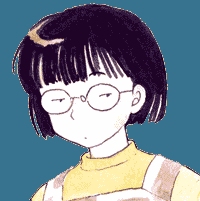

Rumiko Takahashi Interview
What do you think about RIN-NE being the first manga ever to be simultaneously released in both Japan and North America? [1]

Takahashi: I didn’t know that until now [laughs], and it's such an honor, more than I deserve. [2]
How would you compare Sakura and Rinne's relationship with those of the protagonists of your past series?
Takahashi: I’m still feeling my way with them, so I’m not sure how their relationship will unfold. Inwardly, I think it would be great if it develops into a romantic relationship.Where do you get your ideas for the shinigami tools Rinne uses?
Takahashi: I think them up to suit each situation. Many of the items have motifs which are based on Japanese-style things, so they might not seem so familiar to people in America… But who knows, maybe not?How far out have you plotted the story for RIN-NE?
Takahashi: I think it up each week as I go, so even I, the author, have no idea where the story is going.In most of your series there is a supporting character that is very small, such as Shippo in Inuyasha, Jariten (Ten) in Urusei Yatsura, and now Rokumon in RIN-NE. What inspires you to create such characters?
Takahashi: In a sense, they’re sort of like mascots. Also, I think having a smaller character allows for a broader range of perspectives.
Having completed your work on Inuyasha last year, what were your feelings on doing so and what sort of impression do you feel it has left on readers?
Takahashi: It was a long serialization and it was also a heavy story, so I focused on finishing it up in a way that would leave the readers who had read the series for so long with a good feeling. [3]Do you ever feel that your characters take on a life of their own?
Takahashi: Yes, occasionally.
With each new series you create, do you try to show the world more about Japan and its culture, or do you prefer to work towards a more universal story approach?
Takahashi: I’m not consciously doing so, but I’m originally writing for Japanese readers, so the lifestyles portrayed and other elements are Japanese. If readers in America can find it interesting, then I think that’s the best case.
What sort of process do you use in coming up with the character designs; do they come to you right away or do you go through several versions of a character before deciding on one?
Takahashi: I develop character designs as I work on the storyboards for the manga. So I settle on the final designs at the time I reach the final manuscripts (genko). [4]Will you ever return to write more Mermaid Saga stories, or do you consider that series complete?
Takahashi: I don’t consider it complete, so I would like to draw more sometime. [5]
In past interviews, you have sometimes seemed surprised at the popularity of your work outside Japan. Now that so many years have passed since your work became popular overseas, how do you feel about its worldwide popularity?
Takahashi: It makes me think that people everywhere are the same. What makes people laugh or moves them doesn’t change from country to country. And that makes me very happy.Footnotes
- [1] We are leaving Viz's then-current editorial policy here just for curatorial interest. When Kyokai no RINNE was first published in English (digitally) Viz wrote the title (but never the character's name) as RIN-NE. Viz's title for the English adaptation in the physical print format was also always RINNE. A literal translation of the Japanese title would be RINNE of the Boundary (境界のRINNE/Kyokai no RINNE). Thus the RIN-NE stylization was not long-used.
- [2] This is a fascinating bit of triva. Rumiko Takahashi via Kyokai no RINNE, is the first mangaka to have a simultaneous release in Japanese and English. ShonenSunday.com was Viz's first stab at digital manga publication. At the time their (print) Shonen Jump magazine was doing so well that they would not have wanted to jeapordize it by shifting it to a digital imprint. The digital Shonen Sunday launched with the concurrent publication of Kyokai no RINNE. Other titles were offered, though they were not concurrent. They included Arata: The Legend (アラタカンガタリ 〜革神語〜) by Yuu Watase, Case Closed (名探偵コナン) by Gosho Aoyama, Hayate the Combat Butler (ハヤテのごとく!), by Kenjiro Hata, Hyde & Closer (呪法解禁!!ハイド&クローサー) by Haro Aso, Inuyasha, Mermaid Saga and Ranma 1/2 by Rumiko Takahashi, Kekkaishi (結界師) by Yellow Tanabe and Maoh: Juvenile Remix (魔王 ~JUVENILE REMIX~) by Kotaro Isaka and Megumi Osuga.
- [3] Takahashi had just mentioned this same aim, to end the story in an uplifting way, in her interview from 10 months prior.
- [4] The two terms Takahashi is mentioning here are the "name" and the "genko". "Name" (ネーム) are storyboards. These are the rough drawings that layout each page's panel layouts, character positions in each panel, and handwritten dialogue balloons. Some artists ink over their name, others draw on a fresh sheet which preserves the name. After joining Twitter (and on a few rare occasions earlier) Takahashi would share a panel of her name next to the finished panel. "Genko" (原稿) is the finished manuscript pages.
- [5] The following interview was made up of questions Viz had solicited from American fans. The most interesting questions were then chosen to be asked to Takahashi. The 10th question about the Mermaid Saga was submitted by our very own webmaster, Harley Acres.

ShonenSunday.com
|